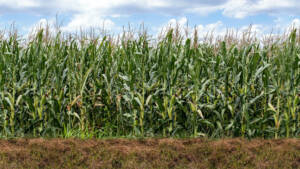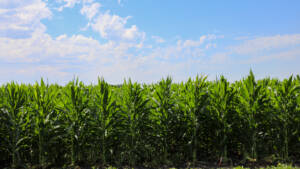
Sustainability Credits and Ecosystem Services Markets

Ecosystem Services: A New Frontier
A new frontier is emerging in agriculture: a market for credits generated by conservation, sustainability and climate-smart practices such as cover crops, livestock grazing, crop rotation, carbon capture and more.
These markets are voluntary, incentive-based platforms that connect buyers and sellers of ecosystem credits. Farmers are typically the sellers. They may be paid for using animal and land management techniques proven to meet certain ecosystem benefit criteria. A common target for these practices is carbon sequestration.
As outlined in a contract, participating farmers opt into some version of data monitoring and measurement procedures. Once enrolled, farmers and ranchers will typically be paid based on measured outcomes, either on a per-acre basis or by the volume of the target asset that is generated.
Once an ecosystem asset is quantified and verified by an outside source, it can be made available for purchase via an ecosystem service market in the form of credits. The credit buyers are often corporations looking to meet sustainability goals and compliance standards.
These ecosystem services markets are constantly evolving, and many are still under development or being refined in pilot stages. The information on this page provides a basic overview as an introduction, not an endorsement. Contracts vary company-by-company and asset-by-asset.
Farmers and ranchers interested in participating in these markets should thoroughly review all contracts with trusted advisors before making a commitment.
Opportunities and Challenges for Farmers
The multitude of emerging platforms and ideas involving agricultural ecosystem credit markets, like those for carbon and water quality, present both opportunities and challenges for farmers. They are an emerging revenue stream, but there are unanswered questions related to regulation, data privacy, market integrity and measurement criteria.
However, advances in technology and increased capital, along with increasing interest from consumers in sustainably raised food, as well as pressure on corporations to reduce their environmental footprint, have increased interest in ecosystem credit markets.
Market Options
Several ecosystem credit markets are already in various stages of development, including markets run by both non-profit and private sector operators.
In an effort to support voluntary, market-based approaches that improve sustainability efforts on our farms and ranches, AFBF, along with many industry partners such as ADM, Cargill, Corteva, Nutrien and Syngenta, participated in the formation of the Ecosystem Services Market Consortium, which is a non-profit market, focused on reducing greenhouse gases and improving water quality.
Other groups that offer payments for ecosystems services include The Soil and Water Outcomes Fund and the New York Outcomes Fund.
Private markets have been launched by companies including Indigo Ag, Nori and Farmers Business Network, as well as agribusinesses, including Bayer and Nutrien, which support and pay for sustainable farming practices.
The payment structure for each market is unique. Some markets pay sellers in cash, while some pay in credits toward supplies like fertilizer or pest control products.
Voluntary and Incentive-Based
AFBF has consistently advocated for ecosystem services markets that are voluntary, incentive-based and economically viable for farmers and ranchers. Quantifiable, verified assets eligible for sale should be those produced by using climate-smart practices on farms and ranches.
As part of its commitment to market-based sustainability solutions, AFBF is a member of Field to Market, an alliance of grower organizations, agribusinesses, brand and retail companies, conservation groups, universities, and public sector partners. Field to Market aims to define, measure and advance the use of sustainable growing practices in ways that growers can be rewarded and supported.
In addition to convening meetings focused on collaboration across the value chain, Field to Market offers a free, online tool for any farmer to use to measure the impact their practices are having on soil health and other environmental benefits. Farmers can use the tool to track data over time for their own records or to use it to sell the credits they have earned. Some examples of climate-smart practices that are already used on farms and ranches across the country include planting cover crops, livestock grazing, conservation tillage, crop rotation, managing nutrient loss or adding trees and shrubs to pastureland to help prevent soil erosion.
According to the EPA, land management practices alone removed 764 million metric tons of CO2 from the atmosphere in 2018. That is equal to taking 165 million vehicles off the road for a year.
Dive Deeper: Market Intel
Through a five-part series of Market Intel articles, AFBF economists break down the ins and outs of ecosystem services markets, including potential pricing for sustainability assets like carbon, commonly used conservation practices in sustainability markets, barriers farmers and ranchers may face to participating in sustainability markets and more.

Sustainability Markets, Part 1: Agricultural Ecosystem Credit Markets – The Primer
Mar 2, 2021
READ MORE

Sustainability Markets, Part 2: Common Land-Use Practices Under Consideration for Conservation Adoption
Mar 9, 2021
READ MORE

Sustainability Markets, Part 3: Barriers to Participation in Ag Ecosystem Credit Markets
Mar 17, 2021
READ MORE

Sustainability Markets, Part 4: Is Carbon a Commodity?
Mar 24, 2021
READ MORE

Sustainability Markets, Part 5: Good Business Practices for Farmers Participating in Agriculture Ecosystem Credit Markets
Apr 27, 2021
READ MORE
Learn More
- USDA Office of Environmental Markets: The Office of Environmental Markets operates within the Office of Energy and Environmental Policy to support the development of emerging sustainability markets, working closely with several USDA agencies, including the Natural Resources Conservation Service, Forest Service and Economic Research Service.
- Partnerships for Climate-Smart Commodities Projects: First announced in 2022, USDA is investing more than $3.1 billion across 141 projects to support the production and marketing of climate-smart commodities via a set of pilot projects lasting one to five years.
Farm Bureau is a member of the Food and Agriculture Climate Alliance, a coalition of more than 80 organizations representing farmers, ranchers, forest owners, agribusinesses, manufacturers, the food and innovation sector, state governments, higher education associations, sportsmen and sportswomen, and environmental advocates. The Alliance advocates for climate-smart policies that are voluntary, market-driven and incentive-based.
TAGS
Top Issues
VIEW ALL